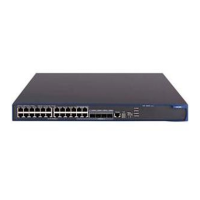1-6
Note:
z When SNMP logging is enabled on a device, SNMP logs are output to the information center of
the device. With the output destinations of the information center set, the output destinations of
SNMP logs will be decided.
z The severity level of SNMP logs is informational, that is, the logs are taken as general prompt
information of the device. To view SNMP logs, you need to enable the information center to
output system information with informational level.
z For detailed description on system information and information center, refer to the Information
Center Configuration part in this manual.
1.5 Displaying SNMP
To do… Use the command… Remarks
Display the SNMP information
about the current device
display snmp-agent sys-info
[
contact
|
location
|
version
]*
Display SNMP packet statistics
display snmp-agent statistics
Display the engine ID of the
current device
display snmp-agent
{
local-engineid
|
remote-engineid
}
Display group information
about the device
display snmp-agent group
[
group-name
]
Display SNMP user information
display snmp-agent usm-user
[
engineid
engineid
|
username
user-name
|
group
group-name
]*
Display trap list information
display snmp-agent trap-list
Display the currently configured
community name
display snmp-agent community
[
read
|
write
]
Display the currently configured
MIB view
display snmp-agent mib-view
[
exclude
|
include
|
viewname
view-name
]
Available in any
view.
1.6 SNMP Configuration Example
1.6.1 SNMP Configuration Example
1. Network requirements
z An NMS and Switch A (SNMP agent) are connected through the Ethernet. The IP address of
the NMS is 10.10.10.1 and that of the VLAN interface on Switch A is 10.10.10.2.
z Perform the following configuration on Switch A: setting the community name and access
permission, administrator ID, contact and switch location, and enabling the switch to sent
traps.
Thus, the NMS is able to access Switch A and receive the traps sent by Switch A.

